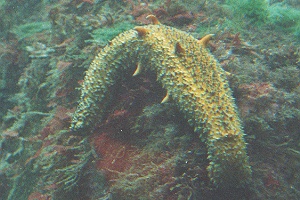- Parastichopus parvimensis
Taxobox
name = Warty sea cucumber

regnum =Animal ia
phylum =Echinodermata
classis =Holothuroidea ia
ordo =Aspidochirotida
familia =Stichopodidae
genus = "Parastichopus "
species = "P. parvimensis"
binomial = "Parastichopus parvimensis"The Warty Sea Cucumber ("Parastichopus parvimensis") is aSea Cucumber that can be found from the Gulf ofAlaska tosouthern California . It is found from the lowintertidal zone to a depth of 250 m. They are most abundant in areas with moderate current with cobbles, boulders or bedrock.Physical description
The Warty Sea Cucumber can grow to a length of 60 cm and a width of 5 cm. It has a soft, cylindrical body, with red-brown to yellowish leathery skin. There are numerous grey spots along its body, hence the name 'warty'. It has an
exoskeleton just below the skin. The mouth and anus are on opposite sides of the body. The mouth is surrounded by ten retractabletentacle s that are used to bring food in. Five rows oftube feet extend from the mouth to the anus. Mobility is limited, though individuals can move up to 4 m per day while feeding.Behavior and reproduction
"P. parvimensis" is a solitary nocturnal animal. It has the ability to regenerate all parts of its body. When threatened, it can expel all its internal organs through its anus and grow new ones. It can also expel sticky filaments to ensnare or confuse predators. It undertakes seasonal migrations to different depths.
These Sea Cucumbers have separate sexes, and eggs are fertilized externally. Spawning usually takes place in November, and each female can produce thousands of eggs. After fertilization, a larva is formed which metamorphoses into a Sea Cucumber after a few weeks.
Wikimedia Foundation. 2010.
